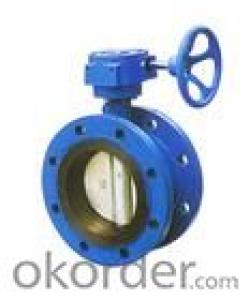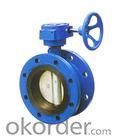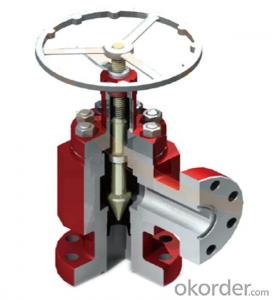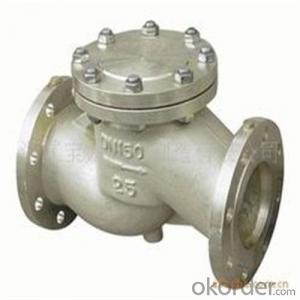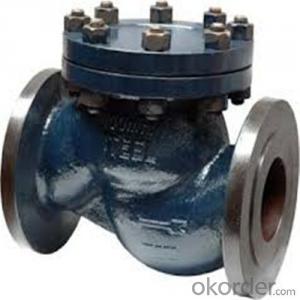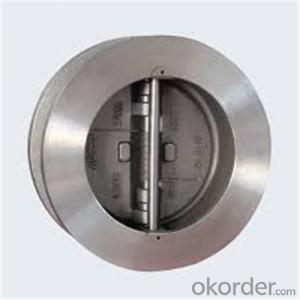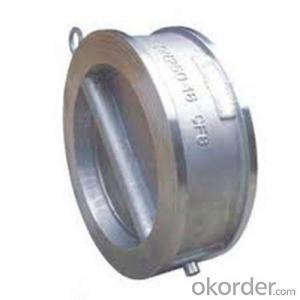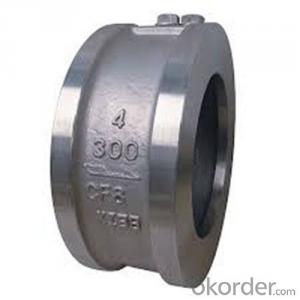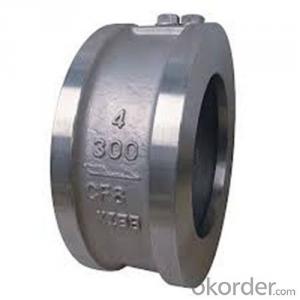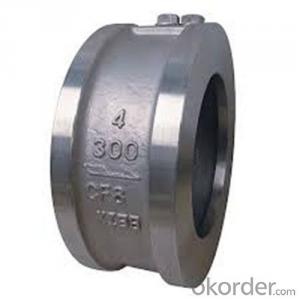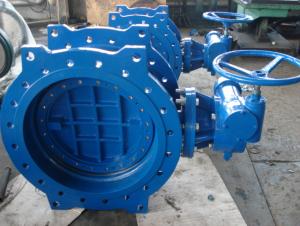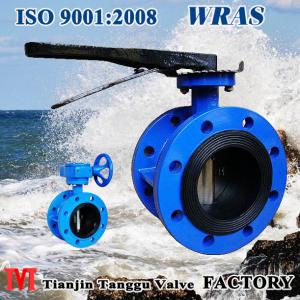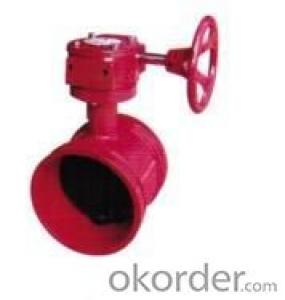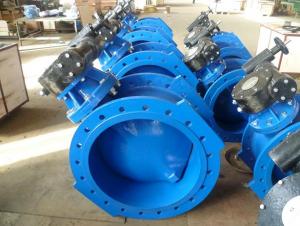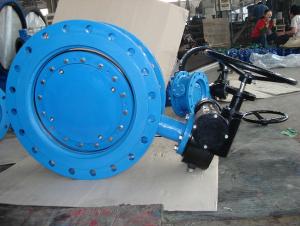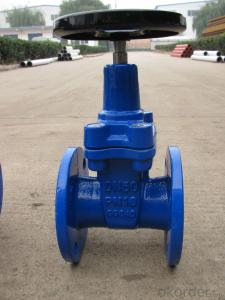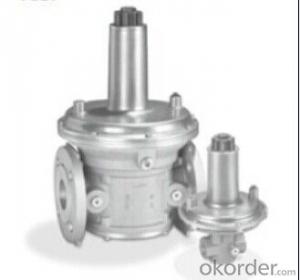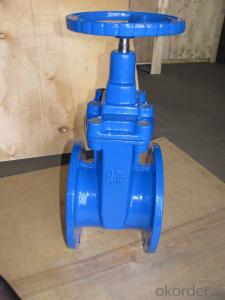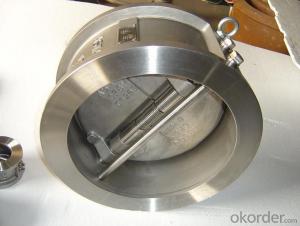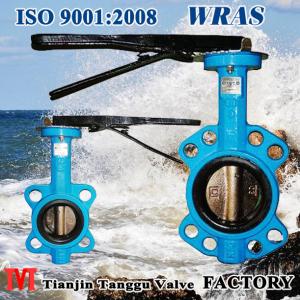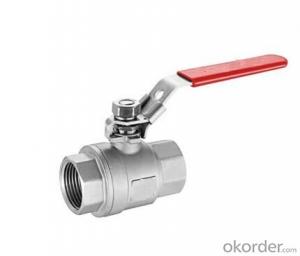Double flanged concentric butterfly valve
- Loading Port:
- China Main Port
- Payment Terms:
- TT OR LC
- Min Order Qty:
- -
- Supply Capability:
- -
OKorder Service Pledge
OKorder Financial Service
You Might Also Like
Specifications
Double flanged Double Eccentric Butterfly Valve
PN10/16/25
DN100 ~ DN2000
Technical Specifications
- Design and manufacture: EN593, EN1074-1 and 2
- Face to face dimension: EN558-1 Series 14 (DIN3202 F4)
EN558-1 Series 13 (BS5163)
- Flange dimensions and drillling: EN1092-2 PN10/16/25
- Size range: DN100 - DN2000
- Max. working pressure: 1.0/1.6/2.5 MPa
- Inspection test: EN12266
- Working temperature: -15°C to +80°C
- Suitable medium: water
Main Fetures
- Double eccentric disc reduces seal wear and torque
- Body seat ring is welded directly on the body
- Bi-directional flow and low head loss
- Disc sealing ring to be replaceable on pipeline without dismantling the valve
- Body and disc inside and outside epoxy powder coated (min. 250 microns)
- Opening and closing indicators are provided
- Coupling flange for electric actuator in compliance with ISO5211
- Gearbox and electric actuator operation available
Main Parts and Materials
Body and disc: ductile iron EN GJS500-7/400-15
Shafts: stainless steel AISI 420
Body seat ring: stainless steel AISI 304
Disc sealing ring: EPDM or NBR
Retaining ring: stainless steel or ductile iron
Shaft bearing: Du bushes (self lubricating bushes)
- Q: It's filling up a 5 gallon bucket roughly ever 9-10 hours. It was leaking with an old valve and has been replaced, and after being replaced it didn't stop. The temperature has not been adjusted higher or lower, it's exactly where it was for the year before the leak started. Any ideas?
- Mike, Since you haven't raised the Temperature setting on the heater which could cause this problem, you either got a bad replacement p/t valve OR maybe it was a cheepo. If that's the case, I would replace it with a good brand return the other one after you find the new on works right.
- Q: Where is the Canister vent shut valve located on a 2003 honda crv
- difficult step. try searching in search engines like google. that will can help!
- Q: How much will it cost to fix 5 broken gas valves out of 6 from my truck it's a Chevy s10 99'I live in North Carolina
- The first step is to realize that you need a professional to work on your truck. This is good. By gas valves I assume you mean fuel injectors. But since you did not know that name it would appear as you have not had your truck properly diagnosed. Sounds like you're not getting fuel? spark? air? compression? in five cylinders in your 4.3-W six cylinder. Might want to find out why. Call around and ask whoever answers the phone if you can speak to an ASE Certified tech. If you talk to one then you have probably found a shop to which it would be worth taking the S10.
- Q: My question mainly pertains to Electric Motor-driven Motor Operated Valve Actuators.
- This Site Might Help You. RE: How does an electric motor operated valve (MOV) actuator work? My question mainly pertains to Electric Motor-driven Motor Operated Valve Actuators.
- Q: i just bought a junky trumpet, didnt come with a mouthpiece... how can i tell that the valves work? They press in and dont stick, but im not sure about their functioning. Also there are no caps on the valves, will this affect playing? lastly, it has a stuck tuning slide, how can i get this to work again?
- whilst i develop into in intense college, I performed on a 3C and had a particularly good sound. in my view, i could in no way visit a smaller, shallower mouthpiece to play intense. i could quite develop my chops and be waiting to do it on a deeper mouthpiece. In college, I switched to and nonetheless at present play a Monette B2, that's analogous length to a a million a million/4C, and characteristic an excellent sound, and might play a intense G (4 ledger lines above the staff) and up on it. i exploit it for any group I play in, marching, stay overall performance, musical theatre, etc... ultimately it boils all the way down to private preferrence. %. the mouthpiece that feels the terrific to you and nonetheless can provide a good sound. you do not pick it so great and deep that your variety and sound go through, and you do not pick is purely too small and shallow which you get too outstanding and tinny of a sound. wish this facilitates.
- Q: also are those air flow limiting valves safe for the air pump to reduce the flow of air, I have one because the air bubbles are just way too many without one and it scares the fish away
- a check valve is to prevent back siphoning of water into the pump if you have a power outage or unplug the pump by accident. I'd suggest checking it by blowing through it the wrong way; if air does pass through get a new check valve (check new ones to be sure they don't limit airflow too much, and that the close in the wrong direction, many are cheap crap and don't work the day you buy them, so check them before you leave the store with it...note: same with thermometers, compare them with each other so you don't get the one that's crap) what you want is a normal air valve, they come in various configurations, one or more valves so as to run multiple airstones and to balance the airflow to each stone or ornament. You should not however just use the valve to limit airflow, as this damages the pump eventually. You can just let one of two valves bleed off a little air; however make sure another check valve is in the line from the tank to the valves or else you risk water coming out of that valve if it's lower than the tank water level.....You may want a smaller air pump or an adjustable one instead.
- Q: Is it hereditary? My dad had a bicuspid valve and we got told it was hereditary but some doctors say it's not, my parents wanted to get me tested in case i had it so we would know in advance but the doctors here refuse to do it (I live in England if that makes a difference) my dad said he would pay to go private if it's hereditary. I know someone who had a bicuspid valve and 3 out of her 4 children inherited it, i know it's pretty harmless until i reach an older age but my parents and i would like to know now, i'm 13 by the way.=]
- I am not sure you and your father want to know if this is hereditary. If you have say have a bicuspid valve now it is not going change any thing. You will still have norma life There are many like living normally
- Q: I heard there are really fine valves, does someone possesses thoughts where to buy these goods? I heard about them on TV. Anybody alive?
- Any plumbing supply shop should have them as well as most home stores, but they are generally for a specific purpose such as at the bottom of a well pick up pipe. Basically a check valve to prevent water from draining back to the well when the pump is off, thus eliminating the need to prime the pump for every on cycle. Al
- Q: i have a 1987 nissan 300zx and i can get the car to start unless its 40 degrees and when it does it idles hard. is this idle control valve or a fast idle valve??
- Could be.. Also could be dirty. Easy fix, remove the valve and spray carb cleaner in the hole.. Using a small brush, clean the bore that the valve rides up and down in. Also, inspect the valve while it is off the manifold. Harder fix: After cleaning the bore, replace valve with brand new one. Your car will have to relearn the idle after starting with the new valve or after you put the old one back in.. Start car, but do not put it in drive or give it any throttle until the computer has finished making adjustments. - Dave. (Long Island, NY)
- Q: emission control valve toyota camry
- Is English your first language? Where is the question?
Send your message to us
Double flanged concentric butterfly valve
- Loading Port:
- China Main Port
- Payment Terms:
- TT OR LC
- Min Order Qty:
- -
- Supply Capability:
- -
OKorder Service Pledge
OKorder Financial Service
Similar products
Hot products
Hot Searches
Related keywords
